Optimal Sizing of Photovoltaic/Energy Storage Hybrid Power Systems: Considering Output Characteristics and Uncertainty Factors
Abstract
:1. Introduction
1.1. Literature Review
1.2. Contribution
- -
- A novel method is proposed to obtain the optimal size of the system and the optimal operating strategy under the optimal size.
- -
- The optimal operating state of the battery energy storage system is obtained and implemented in the energy management strategy.
- -
- The impacts of different components and electricity pricing mechanisms are analyzed on the optimization framework.
- -
- Considering the randomness of the system, a system rolling optimization strategy is proposed.
- -
- Based on the proposed optimization framework, four representative cities in China with different climates are selected for analysis and discussion, demonstrating the robustness of the proposed framework.
2. Structure of the PV-ESS System
2.1. Modeling of PV-ESS System
2.1.1. Modeling of PV Module
2.1.2. Modeling of ESS
2.1.3. Modeling of Converter
3. The Proposed Optimal Operation and Optimal Sizing of the PV-ESS System
3.1. First-Stage
3.1.1. Objective Function and Constraints
- (1)
- Power balance constraint
- (2)
- Capacity constraint of ESS
- (3)
- Power constraint of ESS
3.1.2. Optimization Framework
| Algorithm 1: The optimization framework based on DP. |
| input: The PV-ESS parameters, aggregate of different component sizing systems, initial state of the system, simulation time interval, and length. |
| 1 repeat |
| 2 for each component size system do |
| 3 Divide the stages: Ts = 1 h |
| 4 Identify initial SOC of the ESS: 55% |
| 5 Identify state variable and decision variable: SOCbat and Pbat 6 Build the state transition function: 7 Build the evaluation function: 8 for each optimization interval 9 Optimize in reverse order 10 Update the state of the system 11 Save minimum objective function 12 end 13 Compare and analyze each electric cost 14 Update the optimal capacity allocation based on the minimum objective function 15 end 16 until The simulation length is reached output: The power curve of each component, the optimal component size in theory. |
3.2. Second-Stage
3.2.1. The PV Output Prediction Based on Long Short-Term Memory (LSTM)
3.2.2. The Dispatch Strategy Based on MPC
| Algorithm 2: The Dispatch strategy based on MPC. |
| Input: The PV-ESS parameters, optimal components sizing in theory, initial state of the system, PV output prediction results, simulation time interval and length. |
| 1 repeat |
| 2 for each prediction interval do |
| 3 identify the initial state of system components |
| 4 build the output prediction model of each component: Pbat(k + 1) |
| 5 solve the rolling optimization problem based on DE (according to Section 3.2.2) 6 save the adjusted output sequence: Pbat(k + 1): 7 dispatch according to the first item of the optimization result sequence 8 time window backward 9 if (T ≠ Tmax) 10 then 11 continue rolling optimization 12 update the dispatch sequence 13 else 14 update the optimal prediction interval 15 end 16 end 17 until The simulation length is reached; output: The optimal prediction interval, the dispatch results of each component. |
3.2.3. The Model Solving Based on DE
| Algorithm 3: The Model solving based on DE. |
| input: The PV-ESS parameters, prediction interval. |
| 1 initialize population |
| 2 calculate the fitness of each individual according to the fitness function |
| 3 if (failure, meet the termination conditions) |
| 4 then |
| 5 introduce adaptive mutation operator cross and variation 6 cross and variation 7 consider constraint condition 8 select the next generation population according to the objective function 9 else 10 output optimal individual 11 end 12 save the output sequence output: The optimal output sequence in a prediction interval. |
4. Simulation and Results
4.1. Meteorological Data and Load Profile
4.2. Simulation Results of the First-Stage
4.2.1. The Model Solving Based on DE
4.2.2. The Model Solving Based on DE
4.3. Simulation Results of the Second-Stage
4.3.1. Comparison of Prediction Results
4.3.2. Optimal Dispatch Strategy Based on MPC
4.3.3. Influence of Different Climatic Conditions on Simulation Results
5. Conclusions
Author Contributions
Funding
Data Availability Statement
Conflicts of Interest
References
- Hirsch, A.; Parag, Y.; Guerrero, J. Microgrids: A review of technologies, key drivers, and outstanding issues. Renew. Sustain. Energy Rev. 2018, 90, 402–411. [Google Scholar] [CrossRef]
- Bukar, A.L.; Tan, C.W. A review on stand-alone photovoltaic-wind energy system with fuel cell: System optimization and energy management strategy. J. Clean. Prod. 2019, 221, 73–88. [Google Scholar] [CrossRef]
- Ahmad, R.; Murtaza, A.F.; Sher, H.A. Power tracking techniques for efficient operation of photovoltaic array in solar applications—A review. Renew. Sustain. Energy Rev. 2019, 101, 82–102. [Google Scholar] [CrossRef]
- Jia, Y.T.; Alva, G.; Fang, G.Y. Development and applications of photovoltaic-thermal systems: A review. Renew. Sustain. Energy Rev. 2019, 102, 249–265. [Google Scholar] [CrossRef]
- Yang, D.; Kleissl, J.; Gueymard, C.A.; Pedro, H.T.; Coimbra, C.F. History and trends in solar irradiance and PV power forecasting: A preliminary assessment and review using text mining. Sol. Energy 2018, 168, 60–101. [Google Scholar] [CrossRef]
- Poompavai, T.; Kowsalya, M. Control and energy management strategies applied for solar photovoltaic and wind energy fed water pumping system: A review. Renew. Sustain. Energy Rev. 2019, 107, 108–122. [Google Scholar] [CrossRef]
- Hoque, N.; Kumar, S. Performance of photovoltaic micro utility systems. Energy Sustain. Dev. 2013, 17, 424–430. [Google Scholar] [CrossRef]
- Heinisch, V.; Göransson, L.; Erlandsson, R.; Hodel, H.; Johnsson, F.; Odenberger, M. Smart electric vehicle charging strategies for sectoral coupling in a city energy system. Appl. Energy 2021, 288, 116640. [Google Scholar] [CrossRef]
- Raghuwanshi, S.S.; Arya, R. Reliability evaluation of stand-alone hybrid photovoltaicenergy system for rural healthcare centre. Sustain. Energy Technol. Assess. 2020, 37, 100624. [Google Scholar]
- Mariano-Hernández, D.; Hernández-Callejo, L.; Zorita-Lamadrid, A.; Duque-Pérez, O.; García, F.S. A review of strategies for building energy management system: Model predictive control, demand side management, optimization, and fault detect & diagnosis. J. Build. Eng. 2021, 288, 101692. [Google Scholar]
- Wong, L.A.; Ramachandaramurthy, V.K.; Taylor, P.; Ekanayake, J.B.; Walker, S.L.; Padmanaban, S. Review on the optimal placement, sizing and control of an energy storage system in the distribution network. J. Energy Storage 2019, 21, 489–504. [Google Scholar] [CrossRef]
- Bayram, I.S.; Abdallah, M.; Tajer, A.; Qaraqe, K.A. A Stochastic Sizing Approach for Sharing-Based Energy Storage Applications. IEEE Trans. Smart Grid 2017, 8, 1075–1084. [Google Scholar] [CrossRef] [Green Version]
- Al-Ghussain, L.; Taylan, O.; Baker, D.K. An investigation of PV and wind energy system capacities for alternate short and long-termenergy storage sizing methodologies. Int. J. Energy Res. 2019, 43, 204–218. [Google Scholar] [CrossRef] [Green Version]
- Wang, Y.; Wang, B.; Chu, C.C.; Pota, H.; Gadh, R. Energy management for a commercial building microgrid with stationary and mobile battery storage. Energy Build. 2016, 116, 141–150. [Google Scholar] [CrossRef] [Green Version]
- Abbassi, A.; Dami, M.A.; Jemli, M. A statistical approach for hybrid energy storage system sizing based on capacity distributions in an autonomous PV/Wind power generation system. Renew. Energy 2017, 103, 81–93. [Google Scholar] [CrossRef]
- Sandhu, K.S.; Mahesh, A. A new approach of sizing battery energy storage system for smoothing the power fluctuations of a PV/wind hybrid system. Int. J. Energy Res. 2016, 40, 1221–1234. [Google Scholar] [CrossRef]
- Babacan, O.; Torre, W.; Kleissl, J. Siting and sizing of distributed energy storage to mitigate voltage impact by solar PV in distribution systems. Sol. Energy 2017, 146, 199–208. [Google Scholar] [CrossRef]
- Chaudhari, K.; Ukil, A.; Kumar, K.N.; Manandhar, U.; Kollimalla, S.K. Hybrid Optimization for Economic Deployment of ESS in PV-Integrated EV Charging Stations. IEEE Trans. Ind. Inform. 2018, 14, 106–116. [Google Scholar] [CrossRef]
- Abdelkader, A.; Rabeh, A.; Ali, D.M.; Mohamed, J. Multi-objective genetic algorithm based sizing optimization of a stand-alone wind/PV power supply system with enhanced battery/supercapacitor hybrid energy storage. Energy 2018, 163, 351–363. [Google Scholar] [CrossRef]
- Wang, C.; Yu, B.; Xiao, J.; Guo, L. Sizing of Energy Storage Systems for Output Smoothing of Renewable Energy Systems. Proc. CSEE 2012, 32, 1–8. [Google Scholar]
- Alhaider, M.; Fan, L.L. Planning Energy Storage and Photovoltaic Panels for Demand Response with Heating Ventilation and Air Conditioning Systems. IEEE Trans. Ind. Inform. 2018, 14, 5029–5037. [Google Scholar] [CrossRef]
- Erdinc, O.; Paterakis, N.G.; Pappi, I.N.; Bakirtzis, A.G.; Catalão, J.P. A new perspective for sizing of distributed generation and energy storage for smart households under demand response. Appl. Energy 2015, 143, 26–37. [Google Scholar] [CrossRef]
- Atia, R.; Yamada, N. Sizing and Analysis of Renewable Energy and Battery Systems in Residential Microgrids. IEEE Trans. Smart Grid 2016, 7, 1204–1213. [Google Scholar] [CrossRef]
- Khorramdel, H.; Aghaei, J.; Khorramdel, B.; Siano, P. Optimal Battery Sizing in Microgrids Using Probabilistic Unit Commitment. IEEE Trans. Ind. Inform. 2016, 45, 834–843. [Google Scholar] [CrossRef]
- Eltamaly, A.M.; Alotaibi, M.A. Novel Fuzzy-Swarm Optimization for Sizing of Hybrid Energy Systems Applying Smart Grid Concepts. IEEE Access 2021, 9, 93629–93650. [Google Scholar] [CrossRef]
- Alotaibi, M.A.; Eltamaly, A.M. A Smart Strategy for Sizing of Hybrid Renewable Energy System to Supply Remote Loads in Saudi Arabia. Energies 2021, 14, 7069. [Google Scholar] [CrossRef]
- Riana, A.D.; Jung-Su, K.; Hwachang, S. Suppression of PV Output Fluctuation Using a Battery Energy Storage System with Model Predictive Control. Renew. Sustain. Energy Rev. 2017, 17, 202–209. [Google Scholar]
- Ye, M.; Guo, H.; Cao, B. A model-based adaptive state of charge estimator for a lithium-ion battery using an improved adaptive particle filter. Applied Energy 2017, 190, 740–748. [Google Scholar] [CrossRef]
- Olaszi, B.D.; Ladanyi. Comparison of different discharge strategies of grid-connected residential PV systems with energy storage in perspective of optimal battery energy storage system sizing. Renew. Sustain. Energy Rev. 2016, 75, 710–718. [Google Scholar] [CrossRef]
- Korjani, S.; Casu, F.; Damiano, A.; Pilloni, V.; Serpi, A. An online energy management tool for sizing integrated PV-BESS systems for residential prosumers. Appl. Energy 2022, 313, 118765. [Google Scholar] [CrossRef]
- Wang, T.; O’Neill, D.; Kamath, H. Dynamic Control and Optimization of Distributed Energy Resources in a Microgrid. IEEE Trans. Smart Grid 2015, 6, 2884–2894. [Google Scholar] [CrossRef] [Green Version]
- Gupta, P.; Singh, R. PV power forecasting based on data-driven models: A review. Int. J. Sustain. Eng. 2021, 14, 1733–1755. [Google Scholar] [CrossRef]
- Carneiro, T.C.; de Carvalho PC, M.; Alves dos Santos, H.; Lima MA, F.B.; Braga, A.P.D.S. Review on Photovoltaic Power and Solar Resource Forecasting: Current Status and Trends. J. Sol. Energy Eng. 2022, 144, 010801. [Google Scholar] [CrossRef]
- Kumar, D.S.; Yagli, G.M.; Kashyap, M.; Srinivasan, D. Solar Irradiance Resource and Forecasting: A Comprehensive Review. IET Renew. Power Gener. 2020, 14, 1641–1656. [Google Scholar] [CrossRef]
- Erdener, B.C.; Feng, C.; Doubleday, K.; Florita, A.; Hodge, B.M. A review of behind-the-meter solar forecasting. Renew. Sustain. Energy Rev. 2022, 160, 112224. [Google Scholar] [CrossRef]
- Tawn, R.; Browell. A review of very short-term wind and solar power forecasting. Renew. Sustain. Energy Rev. 2021, 153, 111758. [Google Scholar] [CrossRef]
- Abbassi, A.; Gammoudi, R.; Dami, M.A.; Hasnaoui, O.; Jemli, M. An improved single-diode model parameters extraction at different operating conditions with a view to modeling a photovoltaic generator: A comparative study. Sol. Energy 2017, 155, 478–489. [Google Scholar] [CrossRef]
- Li, W. Framework of probabilistic power system planning. CSEE J. Power Energy Syst. 2015, 1, 1–8. [Google Scholar] [CrossRef]
- Moretón, R.; Lorenzo, E.; Pinto, A.; Muñoz, J.; Narvarte, L. From broadband horizontal to effective in-plane irradiation: A review of modelling and derived uncertainty for PV yield prediction. Renew. Sustain. Energy Rev. 2017, 78, 886–903. [Google Scholar] [CrossRef] [Green Version]
- De la Parra, I.; Muñoz, M.; Lorenzo, E.; García, M.; Marcos, J.; Martínez-Moreno, F. PV performance modelling: A review in the light of quality assurance for large PV plants. Renew. Sustain. Energy Rev. 2017, 78, 780–797. [Google Scholar] [CrossRef] [Green Version]
- Wang, J.; Liu, P.; Hicks-Garner, J.; Sherman, E.; Soukiazian, S.; Verbrugge, M.; Tataria, H.; Musser, J.; Finamore, P. Cycle-life model for graphite-LiFePO4 cells. J. Power Sources 2011, 196, 3942–3948. [Google Scholar] [CrossRef]
- Wu, J.; Xing, X.; Liu, X.; Guerrero, J.M.; Chen, Z. Energy Management Strategy for Grid-tied Microgrids considering the Energy Storage Efficiency. IEEE Trans. Ind. Electron. 2018, 65, 9539–9549. [Google Scholar] [CrossRef] [Green Version]
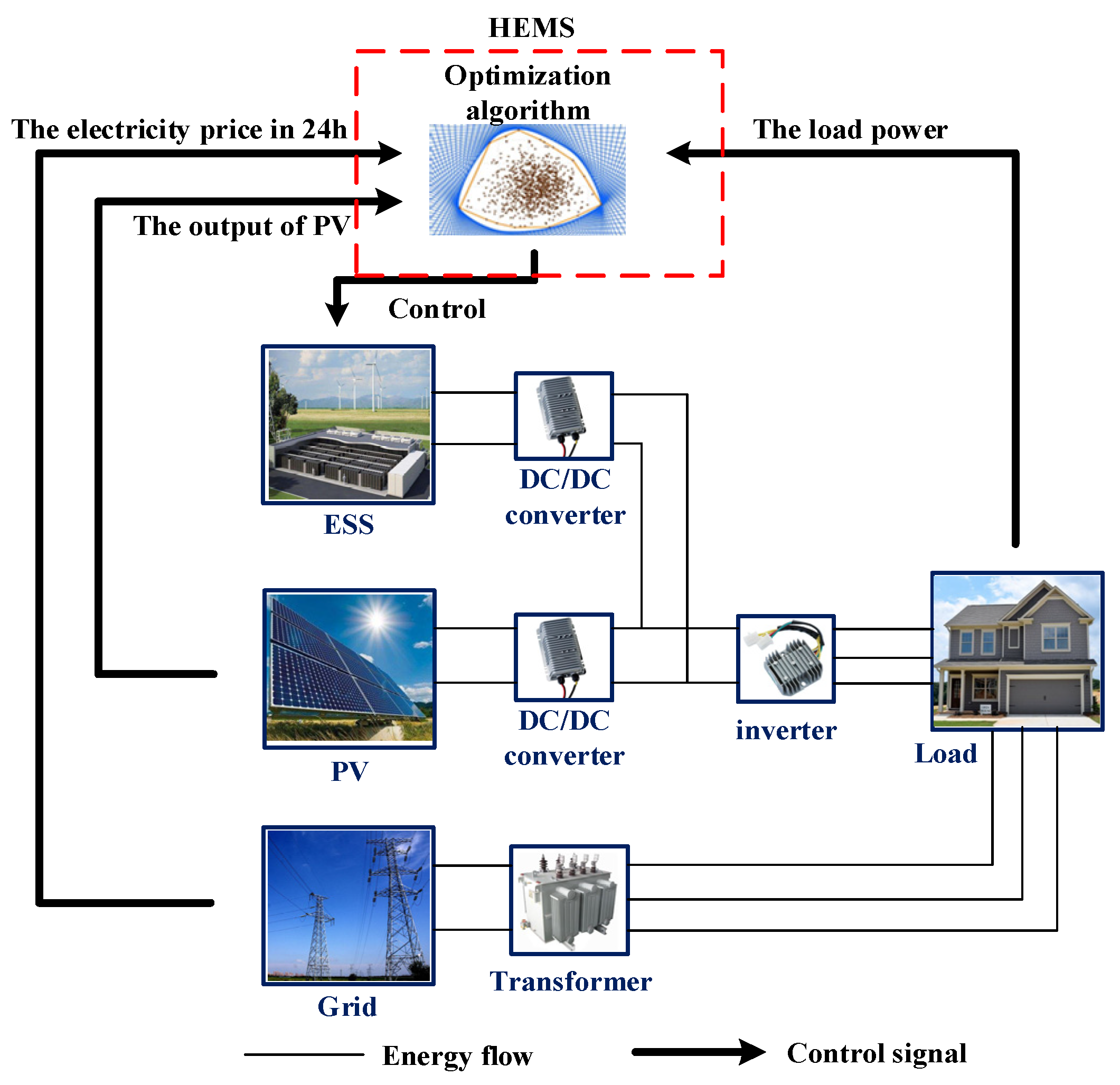
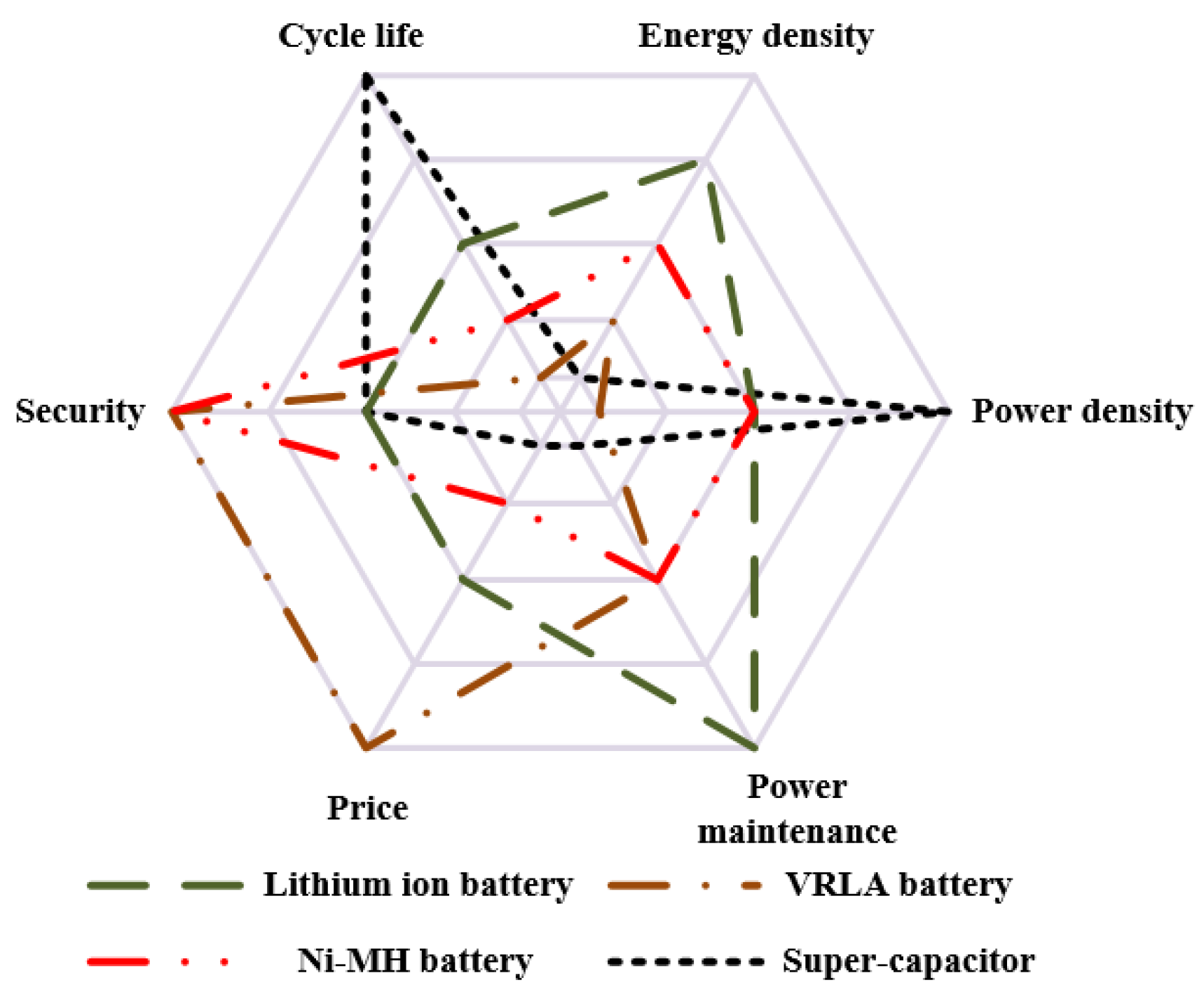

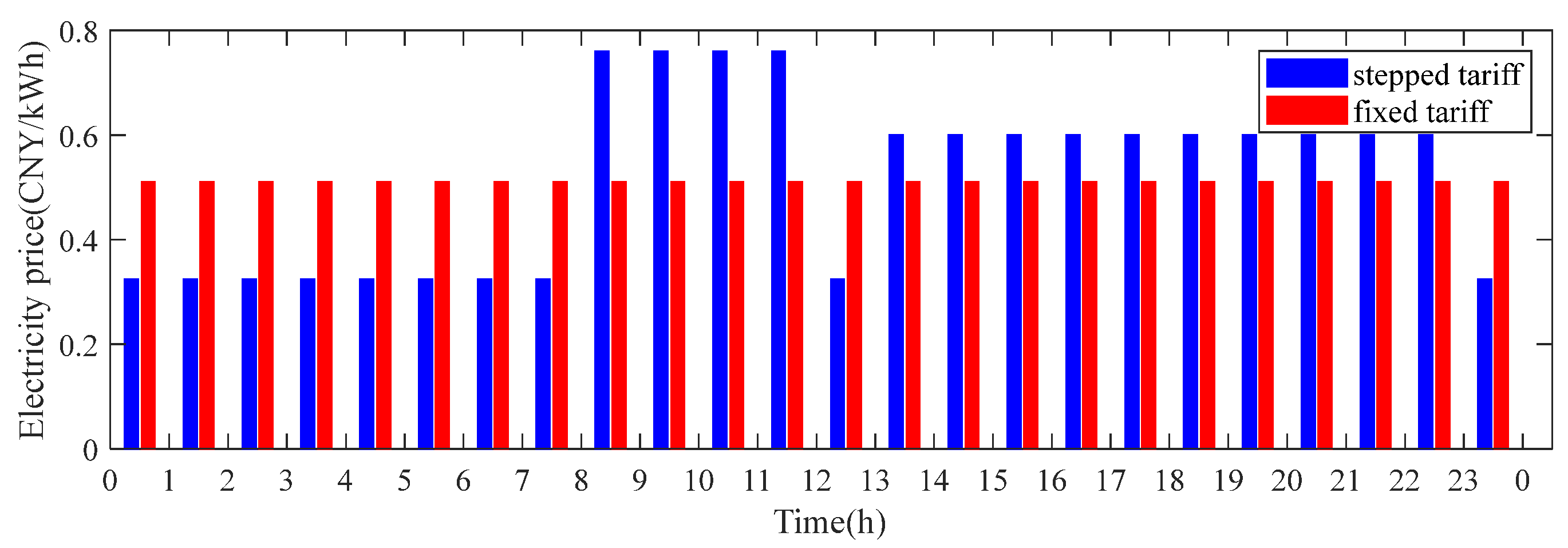

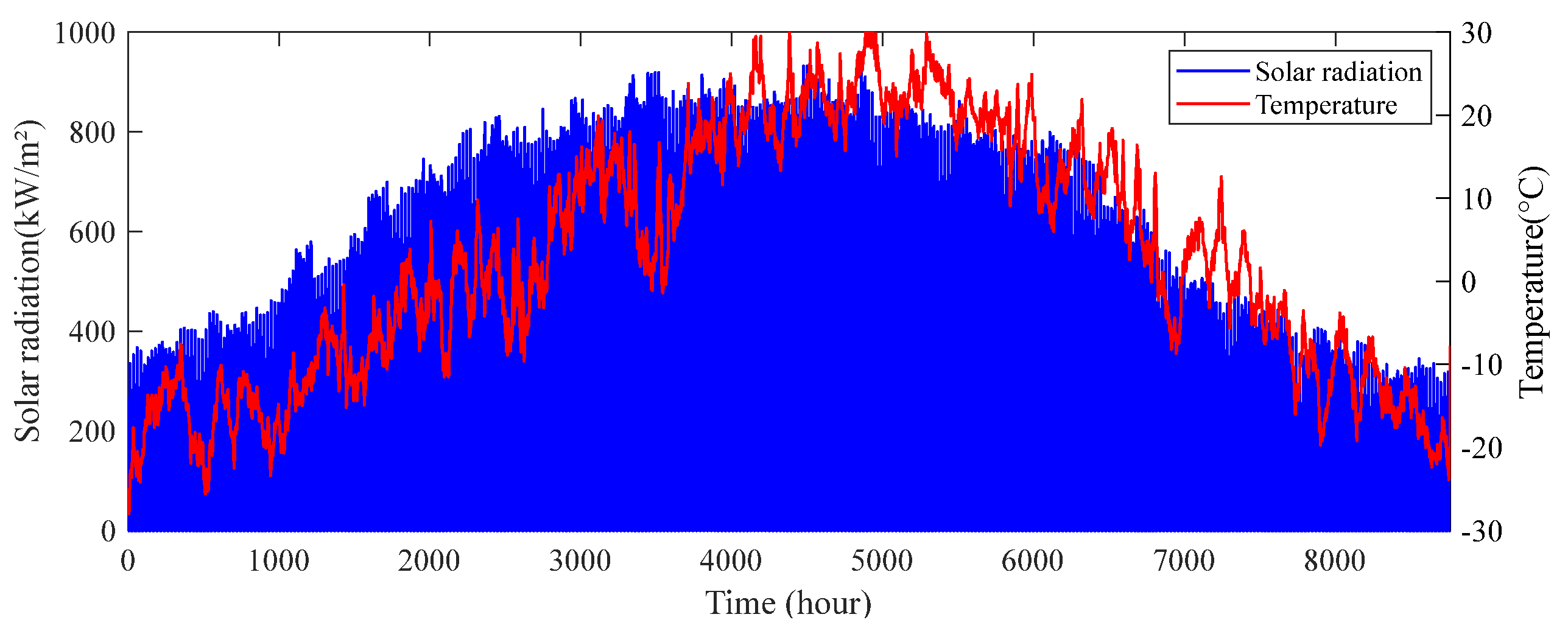

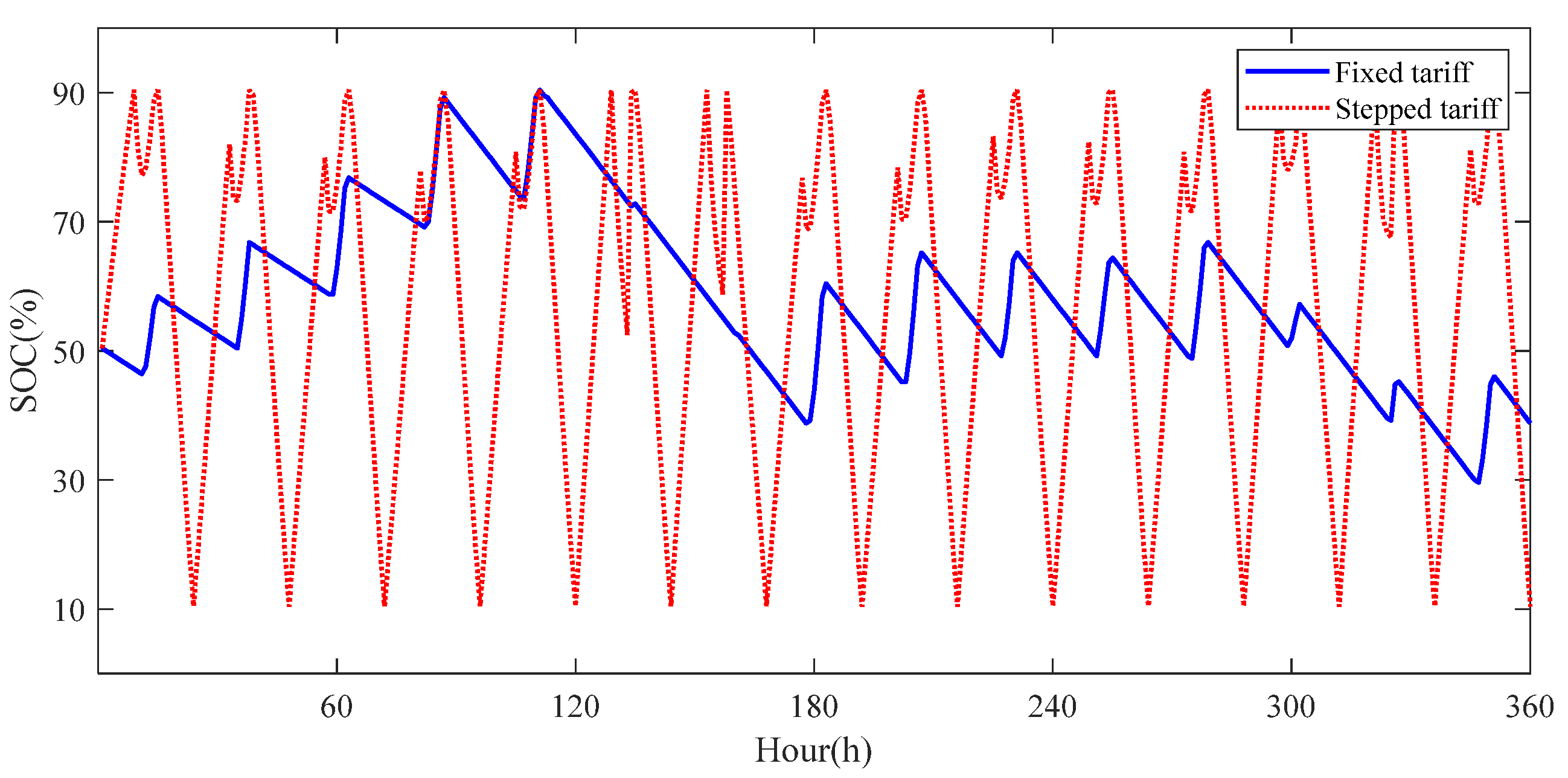

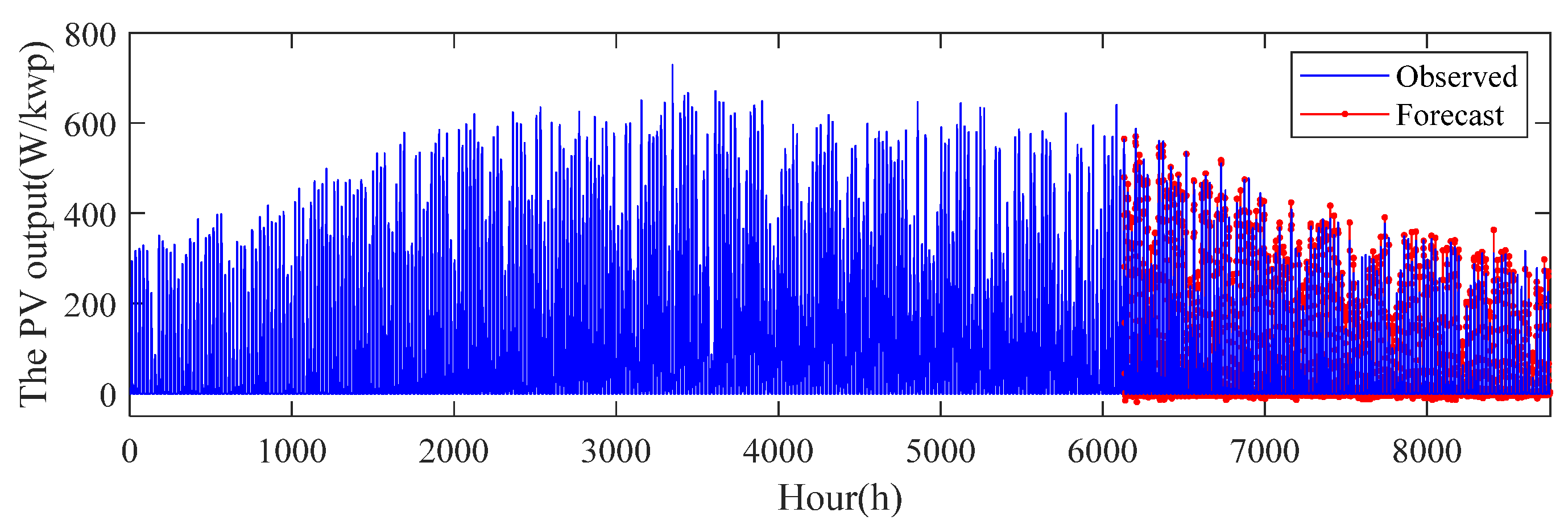
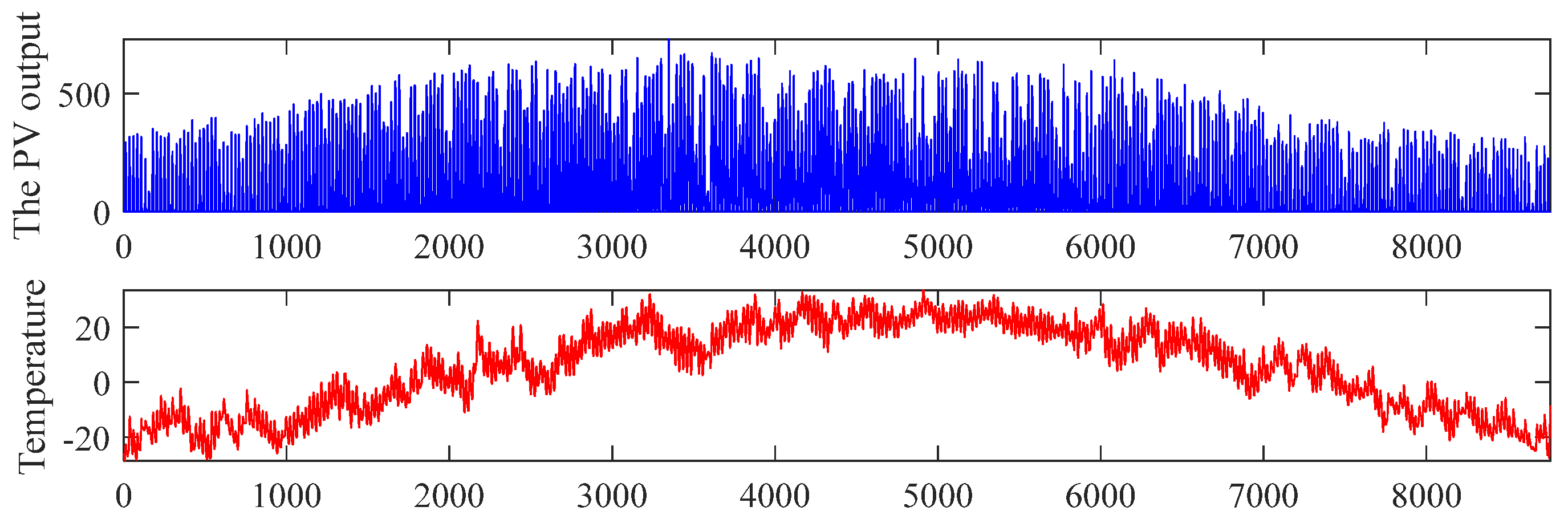


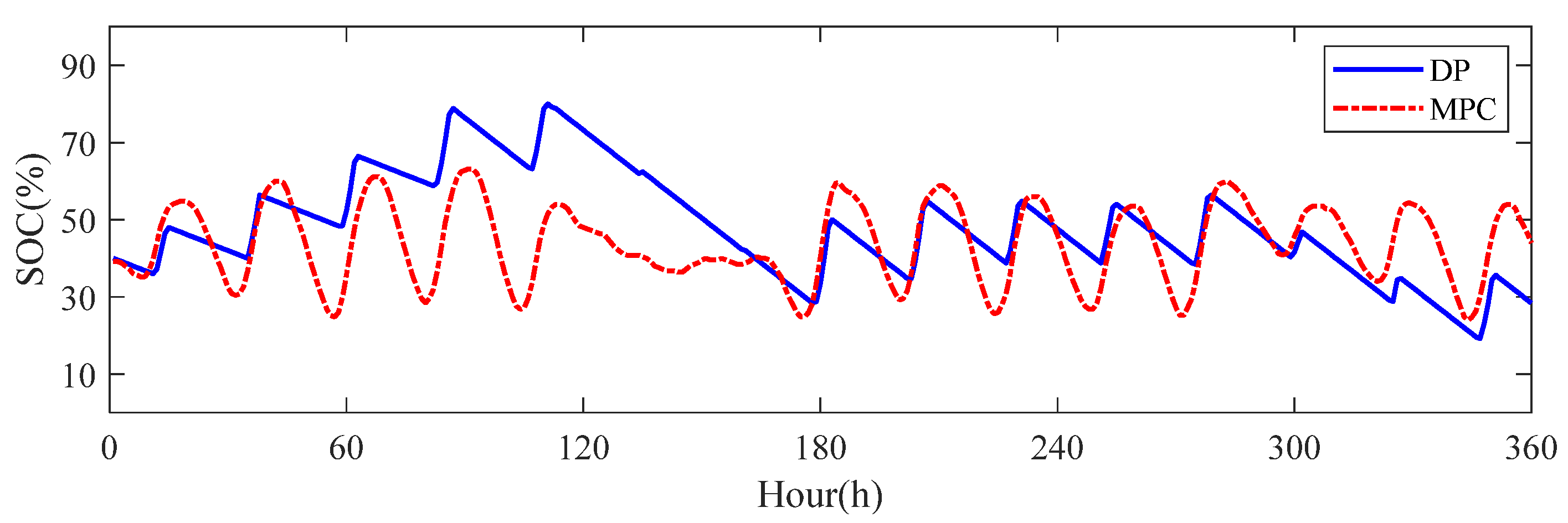
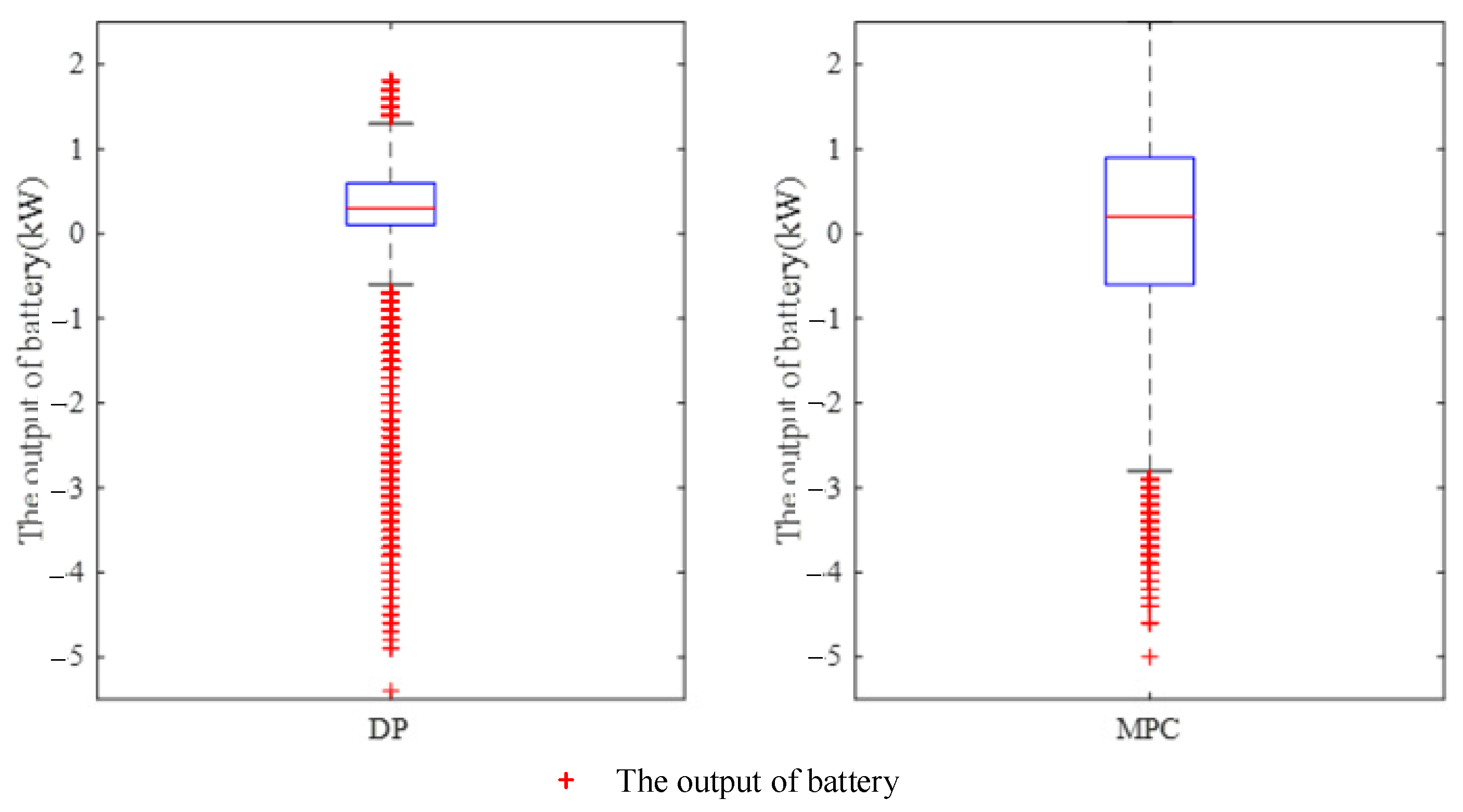
| Component | Characteristic | Value |
|---|---|---|
| PV module | Service life (year) | 15 |
| Unit Price (CNY/Wp) | 1.8 | |
| Battery | Unit Price (CNY/Wh) | 1.85 |
| DOD (%) | 80 | |
| ηbat_ch/ηbat_dis (%) | 95/100 | |
| SC | Service life (year) | 10 |
| Unit Price (CNY/Wh) | 5.5 | |
| DOD (%) | 50 | |
| ηSC_ch/ηSC_dis (%) | 95/100 | |
| Converter | Service life (year) | 10 |
| Unit Price (CNY/W) | 0.2 | |
| ηDC, ηAC (%) | 90 | |
| Degradation model | A0 | 0.0032 |
| B | −1516 | |
| Z | 0.824 | |
| Ea (J/mol) | 15,162 | |
| R (J/(mol·K) | 8.314 | |
| T (K) | 298 |
| Number of Batteries (×5 kWh) | Number of Batteries (×5 kWh) | ||||||||||
|---|---|---|---|---|---|---|---|---|---|---|---|
| Case 1: PV size = 4 kWp, annual electricity saving (CNY) and the degradation of battery (%) of the system | |||||||||||
| SC (kW) | 1 | 2 | 3 | 4 | 5 | SC (kW) | 1 | 2 | 3 | 4 | 5 |
| 0 | 915.1 | 798.46 | 681.71 | 564.9 | 448.1 | 0 | 0.16 | 0.08 | 0.05 | 0.04 | 0.03 |
| 0.4 | 542.8 | 426.03 | 309.18 | 192.3 | 75.5 | 0.4 | 0.10 | 0.05 | 0.03 | 0.02 | 0.02 |
| 0.8 | 170.6 | 53.74 | −63.15 | −180.1 | −296.9 | 0.8 | 0.05 | 0.02 | 0.02 | 0.01 | 0.01 |
| 1.2 | −202.2 | −319.1 | −436.0 | −553.0 | −669.9 | 1.2 | 0.03 | 0.02 | 0.01 | 0.01 | 0.01 |
| 1.6 | −575.6 | −692.5 | −809.4 | −926.4 | −1043 | 1.6 | 0.02 | 0.01 | 0.01 | 0.01 | 0.01 |
| Case 2: PV size = 8 kWp, annual electricity saving (CNY) and the degradation of battery (%) of the system | |||||||||||
| SC (kW) | 1 | 2 | 3 | 4 | 5 | SC (kW) | 1 | 2 | 3 | 4 | 5 |
| 0 | 1434.5 | 1446.7 | 1356.8 | 1242.4 | 1126.7 | 0 | 2.77 | 2.04 | 1.44 | 1.07 | 0.85 |
| 0.4 | 1076.4 | 1079.1 | 985.6 | 871.0 | 755.2 | 0.4 | 2.64 | 1.96 | 1.39 | 1.04 | 0.82 |
| 0.8 | 720.4 | 715.2 | 618.3 | 503.3 | 387.5 | 0.8 | 2.49 | 1.81 | 1.27 | 0.95 | 0.76 |
| 1.2 | 363.9 | 352.3 | 253.1 | 137.7 | 21.7 | 1.2 | 2.38 | 1.71 | 1.19 | 0.89 | 0.71 |
| 1.6 | 6.8 | −11.2 | −112.1 | −227.5 | −343.7 | 1.6 | 2.29 | 1.64 | 1.13 | 0.84 | 0.67 |
| Case 3: PV size = 12 kWp, annual electricity saving (CNY) and the degradation of battery (%) of the system | |||||||||||
| SC (kW) | 1 | 2 | 3 | 4 | 5 | SC (kW) | 1 | 2 | 3 | 4 | 5 |
| 0 | 1133.7 | 1303.1 | 1396.2 | 1435.4 | 1418.2 | 0 | 4.02 | 3.42 | 2.97 | 2.62 | 2.29 |
| 0.4 | 786.9 | 949.1 | 1038.1 | 1072.6 | 1051.2 | 0.4 | 3.93 | 3.37 | 2.94 | 2.59 | 2.27 |
| 0.8 | 440.8 | 597.3 | 682.4 | 712.8 | 687.8 | 0.8 | 3.84 | 3.28 | 2.86 | 2.52 | 2.20 |
| 1.2 | 94.7 | 246.5 | 328.6 | 355.4 | 327.6 | 1.2 | 3.77 | 3.21 | 2.80 | 2.46 | 2.14 |
| 1.6 | −251.9 | −104.6 | −25.3 | −1.56 | −31.7 | 1.6 | 3.70 | 3.16 | 2.75 | 2.41 | 2.09 |
| Case 4: PV size = 16 kWp, annual electricity saving (CNY) and the degradation of battery (%) of the system | |||||||||||
| SC (kW) | 1 | 2 | 3 | 4 | 5 | SC (kW) | 1 | 2 | 3 | 4 | 5 |
| 0 | 454.3 | 725.5 | 921.8 | 1060.9 | 1157.3 | 0 | 4.38 | 4.10 | 3.76 | 3.45 | 3.18 |
| 0.4 | 113.9 | 379.9 | 570.7 | 705.9 | 799.5 | 0.4 | 4.34 | 4.06 | 3.73 | 3.43 | 3.17 |
| 0.8 | −226.8 | 35.3 | 221.9 | 353.6 | 444.3 | 0.8 | 4.31 | 4.01 | 3.68 | 3.37 | 3.12 |
| 1.2 | −567.9 | −309.1 | −126.1 | 3.00 | 90.8 | 1.2 | 4.28 | 3.98 | 3.63 | 3.33 | 3.072 |
| 1.6 | −909.4 | −654.4 | −475.1 | −348.6 | −262.1 | 1.6 | 4.25 | 3.95 | 3.61 | 3.30 | 3.04 |
| Number of Batteries (×5 kWh) | Number of Batteries (×5 kWh) | ||||||||||
|---|---|---|---|---|---|---|---|---|---|---|---|
| Case 1: PV size = 4 kWp, annual electricity saving (CNY) and the degradation of battery (%) of the system | |||||||||||
| SC (kW) | 1 | 2 | 3 | 4 | 5 | SC (kW) | 1 | 2 | 3 | 4 | 5 |
| 0 | 1721.1 | 1868.8 | 1915.6 | 1937.2 | 1949.9 | 0 | 8.52 | 7.63 | 6.81 | 6.23 | 5.87 |
| 0.4 | 1347.4 | 1495.1 | 1541.9 | 1563.5 | 1576.2 | 0.4 | 8.52 | 7.63 | 6.81 | 6.23 | 5.87 |
| 0.8 | 973.6 | 1121.3 | 1168.2 | 1189.7 | 1202.5 | 0.8 | 8.52 | 7.63 | 6.81 | 6.23 | 5.87 |
| 1.2 | 599.9 | 747.6 | 794.4 | 816 | 828.8 | 1.2 | 8.52 | 7.63 | 6.81 | 6.23 | 5.87 |
| 1.6 | 226.2 | 373.9 | 420.7 | 442.3 | 455 | 1.6 | 8.52 | 7.63 | 6.81 | 6.23 | 5.87 |
| Case 2: PV size = 8 kWp, annual electricity saving (CNY) and the degradation of battery (%) of the system | |||||||||||
| SC (kW) | 1 | 2 | 3 | 4 | 5 | SC (kW) | 1 | 2 | 3 | 4 | 5 |
| 0 | 2400.5 | 2578.8 | 2623.5 | 2634.4 | 2639.9 | 0 | 7.01 | 6.05 | 5.59 | 5.33 | 5.17 |
| 0.4 | 2039.5 | 2209 | 2250.9 | 2261.5 | 2266.9 | 0.4 | 6.92 | 6.02 | 5.58 | 5.32 | 5.16 |
| 0.8 | 1678.8 | 1841.1 | 1880.4 | 1890.7 | 1896 | 0.8 | 6.83 | 5.96 | 5.54 | 5.29 | 5.14 |
| 1.2 | 1317.3 | 1473.4 | 1510.5 | 1520.6 | 1525.8 | 1.2 | 6.74 | 5.92 | 5.51 | 5.27 | 5.13 |
| 1.6 | 955.2 | 1105.2 | 1140.3 | 1150.3 | 1155.4 | 1.6 | 6.66 | 5.88 | 5.49 | 5.26 | 5.11 |
| Case 3: PV size = 12 kWp, annual electricity saving (CNY) and the degradation of battery (%) of the system | |||||||||||
| SC (kW) | 1 | 2 | 3 | 4 | 5 | SC (kW) | 1 | 2 | 3 | 4 | 5 |
| 0 | 2136.8 | 2449.3 | 2669.8 | 2831.6 | 2930.4 | 0 | 6.13 | 5.49 | 5.22 | 5.06 | 4.95 |
| 0.4 | 1784.3 | 2089.8 | 2306.5 | 2464.8 | 2560.9 | 0.4 | 6.04 | 5.45 | 5.20 | 5.05 | 4.94 |
| 0.8 | 1432 | 1731.8 | 1945.1 | 2100.3 | 2193.6 | 0.8 | 5.93 | 5.39 | 5.16 | 5.02 | 4.92 |
| 1.2 | 1079.1 | 1374.2 | 1584.2 | 1736.5 | 1827.2 | 1.2 | 5.82 | 5.34 | 5.13 | 4.99 | 4.90 |
| 1.6 | 725.8 | 1015.6 | 1223 | 1372.3 | 1460.6 | 1.6 | 5.72 | 5.30 | 5.09 | 4.97 | 4.88 |
| Case 4: PV size = 16 kWp, annual electricity saving (CNY) and the degradation of battery (%) of the system | |||||||||||
| SC (kW) | 1 | 2 | 3 | 4 | 5 | SC (kW) | 1 | 2 | 3 | 4 | 5 |
| 0 | 1467 | 1872.5 | 2191.7 | 2451.5 | 2644 | 0 | 5.70 | 5.26 | 5.05 | 4.94 | 4.85 |
| 0.4 | 1119.3 | 1519.5 | 1833.8 | 2090.3 | 2280.8 | 0.4 | 5.61 | 5.22 | 5.04 | 4.93 | 4.84 |
| 0.8 | 770.8 | 1167.2 | 1477.5 | 1731.3 | 1919.4 | 0.8 | 5.52 | 5.18 | 5.00 | 4.90 | 4.82 |
| 1.2 | 421.4 | 813.9 | 1120.8 | 1372.2 | 1558.4 | 1.2 | 5.44 | 5.14 | 4.97 | 4.88 | 4.80 |
| 1.6 | 71.2 | 459.8 | 763.6 | 1012.6 | 1197.1 | 1.6 | 5.36 | 5.10 | 4.95 | 4.87 | 4.79 |
| City | Harbin | Beijing | Chongqing | Sanya |
|---|---|---|---|---|
| Highest temperature (°C) | 33.8 | 37.8 | 40.1 | 32.6 |
| lowest temperature (°C) | −28.2 | −18.1 | −8.7 | 13.2 |
| Maximum temperature difference (°C) | 62 | 55.9 | 48.8 | 19.4 |
| Daily sunshine duration (h) | 7.25 | 7.49 | 3.35 | 6.07 |
| Daily power generation (kWh/kWp) | 2.94 | 3.04 | 1.91 | 3.55 |
| Number of Batteries (×10 kWh) | Number of Batteries (×10 kWh) | ||||||||||
|---|---|---|---|---|---|---|---|---|---|---|---|
| Case 1: Harbin, annual electricity saving (CNY) | Case 2: Beijing, annual electricity saving (CNY) | ||||||||||
| PV (kWp) | 1 | 2 | 3 | 4 | 5 | PV (kWp) | 1 | 2 | 3 | 4 | 5 |
| 4 | 798.5 | 564.9 | 331.4 | 97.8 | −135.8 | 4 | 846.6 | 613.1 | 379.5 | 145.9 | −87.7 |
| 8 | 1446.7 | 1242.5 | 1010.7 | 778.0 | 544.9 | 8 | 1546.0 | 1333.6 | 1101.7 | 868.9 | 635.8 |
| 12 | 1303.1 | 1435.5 | 1349.6 | 1133.6 | 902.6 | 12 | 1486.5 | 1621.2 | 1492.2 | 1266.5 | 1035.2 |
| 16 | 725.5 | 1060.9 | 1219.0 | 1186.5 | 1018.1 | 16 | 912.1 | 1315.8 | 1475.2 | 1428.6 | 1235.3 |
| 20 | −80.9 | 409.6 | 712.9 | 793.5 | 678.7 | 20 | 97.4 | 676.9 | 1035.7 | 1149.9 | 1018.7 |
| Case 3: Chongqing, annual electricity saving (CNY) | Case 4: Sanya, annual electricity saving (CNY) | ||||||||||
| PV (kWp) | 1 | 2 | 3 | 4 | 5 | PV (kWp) | 1 | 2 | 3 | 4 | 5 |
| 4 | 37.8 | −195.7 | −429.3 | −662.9 | −896.5 | 4 | 1227.6 | 994.3 | 760.7 | 527.2 | 293.6 |
| 8 | 138.6 | −79.9 | −312.5 | −545.6 | −778.9 | 8 | 2068.0 | 1933.6 | 1703.1 | 1471.0 | 1238.2 |
| 12 | −106.1 | −185.7 | −366.6 | −593.5 | −825.7 | 12 | 1895.1 | 2222.1 | 2247.5 | 2070.5 | 1840.9 |
| 16 | −610.9 | −568.1 | −634.8 | −784.1 | −988.7 | 16 | 1231.9 | 1776.2 | 2136.3 | 2267.1 | 2158.2 |
| 20 | −1276 | −1136 | −1107 | −1176 | −1339 | 20 | 386.6 | 1012.2 | 1543.1 | 1890.6 | 1887.8 |
| Number of Batteries (×10 kWh) | Number of Batteries (×10 kWh) | ||||||||||
|---|---|---|---|---|---|---|---|---|---|---|---|
| Case 1: Harbin, annual electricity saving (CNY) | Case 2: Beijing, annual electricity saving (CNY) | ||||||||||
| PV (kWp) | 1 | 2 | 3 | 4 | 5 | PV (kWp) | 1 | 2 | 3 | 4 | 5 |
| 4 | 1868.8 | 1937.2 | 1957.9 | 1912.5 | 1698.1 | 4 | 1974.8 | 2044.7 | 2065.9 | 1996.4 | 1775.5 |
| 8 | 2578.8 | 2634.4 | 2633.0 | 2509.8 | 2286.7 | 8 | 2809.7 | 2851.7 | 2835.2 | 2672.6 | 2447.0 |
| 12 | 2449.3 | 2831.6 | 2942.6 | 2806.2 | 2588.4 | 12 | 2793.5 | 3172.0 | 3213.0 | 3034.3 | 2811.8 |
| 16 | 1872.5 | 2451.5 | 2737.2 | 2700.9 | 2528.6 | 16 | 2234.7 | 2874.7 | 3097.0 | 3001.0 | 2811.4 |
| 20 | 1063.6 | 1792.8 | 2169.3 | 2167.3 | 2010.8 | 20 | 1426.4 | 2231.6 | 2571.7 | 2537.1 | 2366.4 |
| Case 3: Chongqing, annual electricity saving (CNY) | Case 4: Sanya, annual electricity saving (CNY) | ||||||||||
| PV (kWp) | 1 | 2 | 3 | 4 | 5 | PV (kWp) | 1 | 2 | 3 | 4 | 5 |
| 4 | 1086.8 | 1240.5 | 1280.0 | 1242.3 | 1036.8 | 4 | 2434.4 | 2496.9 | 2513.6 | 2395.7 | 2172.3 |
| 8 | 1333.7 | 1442.3 | 1446.3 | 1336.8 | 1119.6 | 8 | 3446.9 | 3563.7 | 3517.0 | 3318.1 | 3091.4 |
| 12 | 1178.6 | 1394.4 | 1408.9 | 1269.6 | 1049.7 | 12 | 3329.6 | 3895.6 | 4016.4 | 3855.6 | 3644.6 |
| 16 | 731.0 | 1044.7 | 1120.9 | 1017.8 | 826.9 | 16 | 2686.2 | 3457.4 | 3770.5 | 3757.4 | 3613.2 |
| 20 | 105.7 | 496.1 | 618.9 | 555.0 | 392.2 | 20 | 1853.8 | 2691.5 | 3054.9 | 3121.7 | 3014.6 |
Disclaimer/Publisher’s Note: The statements, opinions and data contained in all publications are solely those of the individual author(s) and contributor(s) and not of MDPI and/or the editor(s). MDPI and/or the editor(s) disclaim responsibility for any injury to people or property resulting from any ideas, methods, instructions or products referred to in the content. |
© 2023 by the authors. Licensee MDPI, Basel, Switzerland. This article is an open access article distributed under the terms and conditions of the Creative Commons Attribution (CC BY) license (https://creativecommons.org/licenses/by/4.0/).
Share and Cite
Liu, Y.; Zhong, Y.; Tang, C. Optimal Sizing of Photovoltaic/Energy Storage Hybrid Power Systems: Considering Output Characteristics and Uncertainty Factors. Energies 2023, 16, 5549. https://doi.org/10.3390/en16145549
Liu Y, Zhong Y, Tang C. Optimal Sizing of Photovoltaic/Energy Storage Hybrid Power Systems: Considering Output Characteristics and Uncertainty Factors. Energies. 2023; 16(14):5549. https://doi.org/10.3390/en16145549
Chicago/Turabian StyleLiu, Ye, Yiwei Zhong, and Chaowei Tang. 2023. "Optimal Sizing of Photovoltaic/Energy Storage Hybrid Power Systems: Considering Output Characteristics and Uncertainty Factors" Energies 16, no. 14: 5549. https://doi.org/10.3390/en16145549




